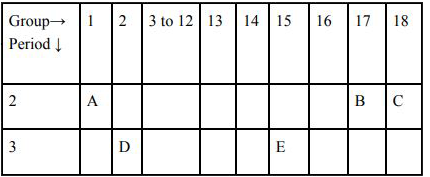Four elements P, Q, R and S have atomic numbers 12, 13, 14 and 15 respectively. Answer the following questions giving reasons :
(i) What is the valency of element Q ? (ii) Classify these elements as metals and non-metals.
(iii) Which of the elements will form the most basic oxide ?
The electronic configuration of the element are as follows :
p (Z = 12), 2, 8, 2 Q (Z = 13) 2, 8, 3
R (Z = 14) , 2, 8, 4 S (Z = 15) 2, 8, 5
(i) The valency of the element Q is 3 since it has three valence electrons.
(ii) The elements P and Q are metals while the elements R and S are non-metals.
(iii) The element P will form the most basic oxide of formula PO.
Topper's Solved these Questions
- PERIODIC CLASSIFICATION OF ELEMENTSBOOK - DINESH PUBLICATIONCHAPTER - PERIODIC CLASSIFICATION OF ELEMENTSEXERCISE - N.C.E.R.T. IN TEXT PROBLEMS
13 Videos
- PERIODIC CLASSIFICATION OF ELEMENTSBOOK - DINESH PUBLICATIONCHAPTER - PERIODIC CLASSIFICATION OF ELEMENTSEXERCISE - N.C.E.R.T. END EXERCISE
10 Videos
- METALS AND NON-METALSBOOK - DINESH PUBLICATIONCHAPTER - METALS AND NON-METALSEXERCISE - MCQ
64 Videos
Similar Questions
Four elements P, Q, R and S have atomic numbers 12, 13, 14 and 15 respectively. Answer the following questions giving reasons :
(i) What is the valency of Q ?
(ii) Classify these elements as metals and non-metals.
(iii) Which of these elements will form the most basic oxide?
View SolutionFour elements P, Q, R and S have atomic numbers 12, 13, 14 and 15 respectively. Answer the following questions giving reasons:
(i) What is the valency of Q ?
(ii) Classify these elements as metals and non-metals.
(iii) Which of these elements will form the most basic oxide?
View Solution
Knowledge Check
Elements P, Q, R and S have atomic numbers 11, 15, 17 and 18 respectively. Which of them are reactive non-metals ?
AP and QBP and RCQ and RDR and SElements P, Q, R and S have atomic numbers 11, 15, 17 and 18 respectively, Which of them are reactive non-metals?
AP and QBP and RCQ and RDR and SElements P, Q, R and Shave atomic numbers 11, 15, 17 and 18 respectively. Which of them are reactive non-metals?
AP and QBP and RCQ and RDR and S
Four elements A, B, C and D have atomic numbers 12, 13, 14 and 15 respectively. Answer the following questions giving reasons:
(a) What is the number of valence electrons and valency of D? (b) Which of them will have largest atomic radii? (c ) Which of these elements will form the most basic oxide?
View SolutionElements P, Q R and S have atomic numbers 11, 15, 17 and 18 respectively. Which of them are reactive non-metals?
View SolutionThe position of certain elements in the Modem Periodic Table are shown below.

Using the above table answer the following questions giving reasons in each case:
(i) Which element will form only covalent compounds?
(ii) Which element is a non-metal with valency 2 ?
(iiii) Which element is a metal with valency 2 ?
(iv) Out of H, C and F which has largest atomic size.
(v) To which family does H, C and F belong.
View SolutionThe following table shows the position of five elements A, B, C, D and E in the modern periodic table.

Answer the following giving reasons:
(i) Which element is a metal with valency two?
(ii) Which element is least reactive?
(iii) Out of D and E which element has a smaller atomic radius?
View SolutionThere are four elements P,Q,R and S having atomic numbers of 4,18,10 and 16 respectively. The element which can exhibit covalency as well as electrovalency will be :
View Solution
